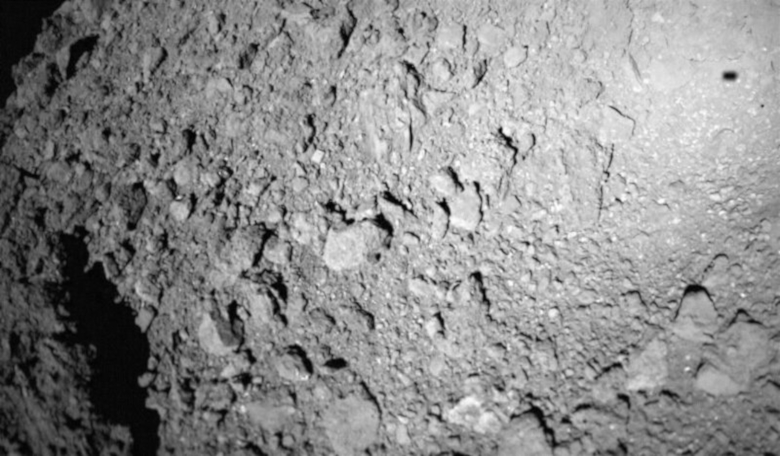New data from Japan’s Hayabusa 2 mission has revealed that the sizeable space rock it had been sent to study – Ryugu – is not as dense as previous predictions have suggested, but instead is a loosely packed rubble pile asteroid that could have been made from cosmic fluffy dust particles.
Now on its way back to Earth armed with samples from the surface of this primitive asteroid, JAXA’s Hayabusa 2 spacecraft had spent a year and half taking detailed observations of this potentially hazardous near-Earth object to learn more about its chemical and physical make-up.
Ryugu is a carbonaceous or c-type asteroid, a common variety of ancient space rock that forms around 80 percent of known asteroids, most of which are strewn about the outer edges of the asteroid belt.
Scientists are interested in c-type asteroids because their composition is thought to be similar to that of the Sun, and as relics of the early Solar System, their primitive materials have remained relatively unchanged since their formation approximately 4.6 billion years ago.
Occasionally, fragments of this type of asteroid find themselves on Earth as carbonaceous chondritic meteorites; at least that is where these type of meteorites are thought to originate from, but as they tend not to survive entry through Earth’s atmosphere very well, it is hard to say with 100 percent certainty.
Collecting an actual sample from a c-type asteroid in-situ would certainly go a long way to understanding more about planetary formation processes and this was one of the reasons why Hayabusa 2 travelled over 220 million kilometres, plus the return mileage, to visit this one kilometre-wide, diamond shaped space rock.
During its time at its target, Hayabusa 2 also made a number of global thermal infrared images of the asteroid from its “home position” 20 kilometres earthwards from Ryugu, to confirm previously predicted measurements of its size, rotation rate and albedo.
However a spectroscopic analysis of some of its mineral content also revealed that the chemical compounds were not as hydrated as scientists thought.
Further studies of the asteroid by a team headed by Tatsuaki Okada at the Institute of Space and Astronautical Science (ISAS) in Japan, have now shown that the asteroid’s boulders which litter the surface, and their surroundings have similar temperatures; a result they determined from studies of the asteroids thermal inertia.
Thermal inertia is the degree of slowness with which the temperature of a body approaches that of its surroundings and which is dependent upon its absorptivity, its specific heat, its thermal conductivity, its dimensions, and other factors.
Ryugu’s thermal inertia was low, suggesting that “the boulders are more porous than typical carbonaceous chondrites and that their surroundings are covered with porous fragments more than 10 centimetres in diameter,” say the international team of scientists in their paper recently published in Nature.
This finding is backed up by close-up thermal images which confirm the presence of such porous fragments say the team.
Some of the boulders that are colder during the day, correspond to dense boulders similar to typical carbonaceous chondrites, add Okada and colleagues.
All of this points to Ryugu being an ancient loosely packed rubble pile asteroid made of porous materials that formed under low gravity conditions.
To get this way, it first started with the impact of countless fluffy dust particles that grew into a planetesimal. Whether the baby planet remained porous throughout or a dense core formed is not certain, but at some point a catastrophic collision with another object smashed bits off the parent body. These re-accreted with mainly porous boulders to create a rubble-piled, top-shaped asteroid.
If planetesimals do form from fluffy dust particles then this could have had the knock-on effect of strongly affecting planetary formation processes such as cratering and collisional fragmentation by allowing shocks to pass through them more easily, write the team in their paper.
The researchers do note however, that Ryugu’s low thermal inertia and low density could arise from “surface materials different from carbonaceous chondrites, such as the organic surface-rich material discovered on comet 67P/Churymov-Gerasimenko.”
This say the team, can be answered more conclusively once the samples winging their way back through space are analysed by labs on Earth.











